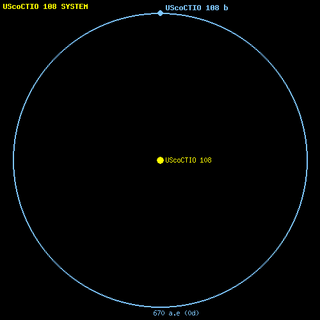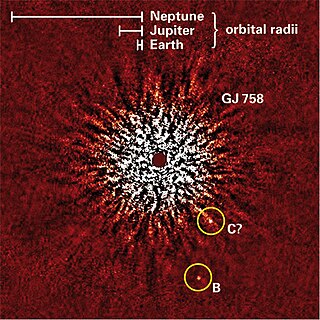
An exoplanet or extrasolar planet is a planet outside the Solar System. The first possible evidence of an exoplanet was noted in 1917 but was not recognized as such. The first confirmation of detection occurred in 1992. A different planet, initially detected in 1988, was confirmed in 2003. As of 1 February 2023, there are 5,307 confirmed exoplanets in 3,910 planetary systems, with 853 systems having more than one planet. The James Webb Space Telescope (JWST) is expected to discover more exoplanets, and also much more about exoplanets, including composition, environmental conditions and potential for life.

Brown dwarfs are substellar objects that are not massive enough to sustain nuclear fusion of ordinary hydrogen (1H) into helium in their cores, unlike a main-sequence star. Instead, they have a mass between the most massive gas giant planets and the least massive stars, approximately 13 to 80 times that of Jupiter (MJ). However, they can fuse deuterium (2H) and the most massive ones can fuse lithium (7Li).

Gliese 229 is a binary system composed of a red dwarf and the first brown dwarf seen by astronomers, 18.8 light years away in the constellation Lepus. The primary component has 58% of the mass of the Sun, 69% of the Sun's radius, and a very low projected rotation velocity of 1 km/s at the stellar equator.

Rho Coronae Borealis is a yellow dwarf star approximately 57 light-years away in the constellation of Corona Borealis. The star is thought to be similar to the Sun with nearly the same mass, radius, and luminosity. It is orbited by two known exoplanets.

Honores Friderici or Frederici Honores, also called Gloria Frederica or Frederici was a constellation created by Johann Bode in 1787 to honor Frederick the Great, the king of Prussia who had died in the previous year. It was between the constellations of Cepheus, Andromeda, Cassiopeia and Cygnus. Its most important stars were Iota, Kappa, Lambda, Omicron, and Psi Andromedae. The constellation is no longer in use.

Kappa Andromedae, Latinized from κ Andromedae, is the Bayer designation for a bright star in the northern constellation of Andromeda. It is visible to the naked eye with an apparent visual magnitude of 4.1. Based on the star's ranking on the Bortle Dark-Sky Scale, it is luminous enough to be visible from the suburbs and from urban outskirts, but not from brightly lit inner city regions. Parallax measurements made during the Hipparcos mission place it at a distance of approximately 168 light-years from the Sun. It is drifting closer with a radial velocity of −15 km/s, and there is a high likelihood (86%) that it is a member of the Beta Pictoris moving group. The star has one known companion exoplanet, Kappa Andromedae b.
HD 38529 is a binary star approximately 138 light-years away in the constellation of Orion.

A sub-brown dwarf or planetary-mass brown dwarf is an astronomical object that formed in the same manner as stars and brown dwarfs but that has a planetary mass, therefore by definition below the limiting mass for thermonuclear fusion of deuterium . Some researchers call them free-floating planets whereas others call them planetary-mass brown dwarfs. They are sometimes categorized as Y spectral class brown dwarfs.

XO-3b is an exoplanet with about 11.79 times the mass of Jupiter, and it orbits its parent star in about 3.2 days. The radius of this object is 1.217 times that of Jupiter. Astronomers announced their discovery on May 30, 2007, at the American Astronomical Society in Honolulu, Hawaii. Its discovery is attributed to the combined effort of amateur and professional astronomers working together on the XO Project using a telescope located on the Haleakala summit in Hawaii.
Gliese 86 is a K-type main-sequence star approximately 35 light-years away in the constellation of Eridanus. It has been confirmed that a white dwarf orbits the primary star. In 1998 the European Southern Observatory announced that an extrasolar planet was orbiting the star.
A substellar object, sometimes called a substar, is an astronomical object the mass of which is smaller than the smallest mass at which hydrogen fusion can be sustained. This definition includes brown dwarfs and former stars similar to EF Eridani B, and can also include objects of planetary mass, regardless of their formation mechanism and whether or not they are associated with a primary star.
HD 190228 is a star with a non-stellar companion in the constellation Vulpecula. Its apparent magnitude is 7.30 – too faint to be seen with the naked eye – and the absolute magnitude is 3.34. Based on parallax measurements, it is located at a distance of 205 light years from the Sun. The star is older than the Sun with an age over 5 billion years and it is metal-poor.
36 Ursae Majoris is a double star in the northern constellation of Ursa Major. With an apparent visual magnitude of 4.8, it can be seen with the naked eye in suitable dark skies. Based upon parallax measurements, this binary lies at a distance of 42 light-years from Earth.
AB Doradus Moving Group is a group of about 30 associated stars that are moving through space together with the star AB Doradus. A moving group is distinguished by its members having about the same age, composition and motion through space. Hence they most likely formed in the same location.

UScoCTIO 108 is a binary system, approximately 470 light-years away in the Upper Scorpius (USco) OB association. The primary, UScoCTIO 108A, with mass around 0.06 solar masses, is a brown dwarf or low-mass red dwarf. The secondary, UScoCTIO 108B, with a mass around the deuterium burning limit of 13 Jupiter masses, would be classified as either a brown dwarf or an extrasolar planet.
HD 16760 is a binary star system approximately 227 light-years away in the constellation Perseus. The primary star HD 16760 is a G-type main sequence star similar to the Sun. The secondary, HIP 12635 is 1.521 magnitudes fainter and located at a separation of 14.6 arcseconds from the primary, corresponding to a physical separation of at least 660 AU. Announced in July 2009, HD 16760 has been confirmed to have a red dwarf orbiting it, formerly thought to be a brown dwarf or exoplanet.

Gliese 758 is a star in the northern constellation of Lyra. At about magnitude 6 it is a challenge to view with the naked eye even in good seeing conditions, but can be easily seen through a small telescope or binoculars. Parallax measurements from the Hipparcos mission give it an estimated distance of around 50.9 light-years from Earth.
Deuterium fusion, also called deuterium burning, is a nuclear fusion reaction that occurs in stars and some substellar objects, in which a deuterium nucleus and a proton combine to form a helium-3 nucleus. It occurs as the second stage of the proton–proton chain reaction, in which a deuterium nucleus formed from two protons fuses with another proton, but can also proceed from primordial deuterium.

Strategic Explorations of Exoplanets and Disks with Subaru (SEEDS) is a multi-year survey that used the Subaru Telescope on Mauna Kea, Hawaii in an effort to directly image extrasolar planets and protoplanetary/debris disks around hundreds of nearby stars. SEEDS is a Japanese-led international project. It consists of some 120 researchers from a number of institutions in Japan, the U.S. and the EU. The survey's headquarters is at the National Astronomical Observatory of Japan (NAOJ) and led by Principal Investigator Motohide Tamura. The goals of the survey are to address the following key issues in the study of extrasolar planets and disks: the detection and census of exoplanets in the regions around solar-mass and massive stars; the evolution of protoplanetary disks and debris disks; and the link between exoplanets and circumstellar disks.
VHS J125601.92–125723.9 is a young triple brown dwarf system located in the constellation Corvus approximately 69.0 light-years from the Sun. The system consists of the equal-mass binary VHS J1256–1257AB and the distant planetary-mass companion VHS 1256–1257 b. In 2022, a continuous radio emission from the radiation belts surrounding VHS J1256–1257 was detected.














